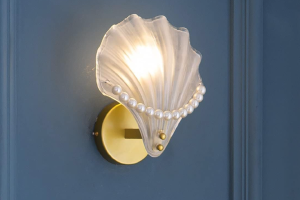Embracing Wabi-Sabi: Plaster Textured Wall Lamp
6 min readWabi-sabi is a Japanese aesthetic philosophy that finds beauty in the imperfect, the transient, and the incomplete. Rooted in Zen Buddhism, this concept encourages an appreciation for the natural cycle of growth and decay, emphasizing that nothing is permanent and that beauty can be found in the most unexpected places. The term “wabi” originally referred to the simplicity and rusticity of rural life, while “sabi” denotes the beauty that comes with age and wear.
Together, they create a worldview that celebrates the authenticity of objects and experiences, inviting individuals to embrace the flaws and irregularities that make life unique. In a world increasingly dominated by mass production and perfectionism, wabi-sabi offers a refreshing perspective. It challenges the conventional notions of beauty that often prioritize symmetry, uniformity, and pristine conditions.
Instead, wabi-sabi encourages us to look beyond surface appearances and appreciate the stories behind objects—the cracks in a ceramic bowl that reveal its history, or the faded colors of a well-loved textile that speak to its journey through time. This philosophy invites us to slow down, observe our surroundings, and cultivate a deeper connection with the world around us.
The Beauty of Imperfection:
The beauty of imperfection is a central tenet of wabi-sabi, manifesting in various forms across art, design, and everyday life. This aesthetic celebrates asymmetry, irregularity, and the passage of time, suggesting that flaws can enhance an object’s character rather than detract from it. For instance, consider a handmade pottery piece with an uneven glaze or an organic shape; these imperfections tell a story of human touch and creativity, making each item unique.
In contrast to mass-produced items that often prioritize uniformity, wabi-sabi encourages us to seek out those one-of-a-kind treasures that reflect individuality. Moreover, embracing imperfection extends beyond physical objects; it also applies to our personal lives. The acceptance of our own flaws and vulnerabilities can lead to greater self-compassion and authenticity.
In relationships, for example, acknowledging imperfections can foster deeper connections as we learn to appreciate each other’s quirks and idiosyncrasies. This shift in perspective allows us to cultivate a sense of gratitude for the imperfect moments that shape our experiences, ultimately enriching our lives in profound ways.
Embracing Minimalism:
Minimalism aligns closely with the principles of wabi-sabi, advocating for simplicity and intentionality in our surroundings. By reducing clutter and focusing on what truly matters, we create spaces that reflect our values and promote mindfulness. A minimalist approach encourages us to curate our possessions thoughtfully, choosing items that resonate with us on a personal level rather than accumulating things for the sake of appearances.
This practice not only enhances our living environment but also fosters a sense of clarity and peace in our minds. Incorporating minimalism into our lives can be as simple as decluttering a single room or as comprehensive as reevaluating our entire lifestyle. The key is to prioritize quality over quantity, selecting items that embody the essence of wabi-sabi—those that may show signs of wear or have an imperfect charm.
For example, a well-worn wooden table with scratches from years of family gatherings can evoke warmth and nostalgia, serving as a reminder of cherished memories rather than merely a functional piece of furniture. By embracing minimalism through the lens of wabi-sabi, we create spaces that are not only aesthetically pleasing but also deeply meaningful.
Incorporating Natural Elements:
Nature plays a pivotal role in wabi-sabi aesthetics, emphasizing organic materials and forms that reflect the beauty of the natural world. Incorporating elements such as wood, stone, clay, and textiles made from natural fibers can create a harmonious environment that resonates with the principles of this philosophy. For instance, reclaimed wood furniture not only adds character to a space but also tells a story of sustainability and resourcefulness.
The knots and imperfections in the wood serve as reminders of its journey through time, inviting us to appreciate its unique history. Additionally, bringing plants into our homes can enhance the wabi-sabi aesthetic by introducing life and vitality into our spaces. The presence of greenery not only purifies the air but also connects us to the rhythms of nature.
A simple arrangement of wildflowers in an unglazed ceramic vase can evoke a sense of tranquility and spontaneity, embodying the essence of wabi-sabi. By incorporating natural elements into our decor, we create environments that feel grounded and authentic, fostering a deeper connection to both our surroundings and ourselves.
Creating a Serene Atmosphere:
A serene atmosphere is essential for embracing wabi-sabi in our homes. This tranquility can be achieved through thoughtful design choices that prioritize comfort and simplicity. Soft lighting, muted color palettes, and uncluttered spaces contribute to an environment where one can unwind and reflect.
For example, using warm-toned lighting fixtures can create an inviting ambiance that encourages relaxation and introspection. The gentle glow of candlelight or the soft illumination from paper lanterns can evoke a sense of calmness reminiscent of traditional Japanese tea houses. Sound also plays a crucial role in establishing serenity within a space.
Incorporating elements such as water features or wind chimes can introduce soothing sounds that enhance the overall atmosphere. The gentle trickle of water or the soft tinkling of chimes can create a meditative environment conducive to mindfulness practices like meditation or yoga. By curating an atmosphere that prioritizes serenity, we align ourselves with the principles of wabi-sabi, allowing us to appreciate the present moment fully.
The Art of Plaster Texturing:
Plaster texturing is an art form that beautifully embodies the principles of wabi-sabi through its inherent imperfections and organic qualities. Unlike smooth drywall finishes that often emphasize uniformity, textured plaster walls celebrate irregularities and variations in color and texture. Techniques such as troweling or sponging can create surfaces that evoke a sense of depth and character, transforming ordinary walls into works of art.
The tactile nature of plaster also invites interaction; running your fingers over a textured surface can evoke feelings of warmth and connection. Additionally, plaster’s ability to absorb light creates dynamic visual effects throughout the day as shadows shift and change. This interplay between light and texture aligns perfectly with wabi-sabi’s celebration of transience and imperfection.
By incorporating plaster texturing into our homes, we not only enhance their aesthetic appeal but also create spaces that invite contemplation and appreciation for the beauty found in imperfection.
Illuminating with Warmth:
Lighting is a crucial element in any design scheme, particularly when embracing wabi-sabi aesthetics. The choice of lighting fixtures can significantly impact the mood and atmosphere within a space. Opting for warm-toned bulbs rather than harsh white lights creates an inviting environment that fosters relaxation and comfort.
Soft lighting enhances the textures and colors present in natural materials while casting gentle shadows that add depth to the overall design. In addition to choosing warm lighting options, incorporating various light sources can create layers within a space. Combining ambient lighting with task lighting—such as table lamps or wall sconces—can provide both functionality and aesthetic appeal.
The interplay between different light sources allows for versatility in how we experience our environments throughout the day. By thoughtfully illuminating our spaces with warmth and intention, we align ourselves with wabi-sabi principles while creating inviting atmospheres conducive to reflection and connection.
Embracing Wabi-Sabi in Your Home Decor:
Embracing wabi-sabi in home decor involves more than just selecting aesthetically pleasing items; it requires cultivating an attitude of appreciation for imperfection and authenticity in every aspect of our living spaces. Start by curating your collection of belongings with intention—choose pieces that resonate with you personally rather than those dictated by trends or societal expectations. This could mean displaying cherished heirlooms alongside contemporary art or incorporating handmade items from local artisans.
Additionally, consider how you arrange your decor to reflect the principles of wabi-sabi. Allow for negative space within your design; this breathing room emphasizes each piece’s individuality while creating a sense of balance within the overall composition. Layering textures—such as combining soft textiles with rough-hewn wood—can further enhance this aesthetic by celebrating contrasts inherent in nature.
Ultimately, embracing wabi-sabi in home decor invites us to slow down and appreciate life’s fleeting moments while surrounding ourselves with objects that tell stories—both their own and ours. By fostering an environment rooted in authenticity, simplicity, and connection to nature, we create spaces where we can truly thrive amidst life’s imperfections.


